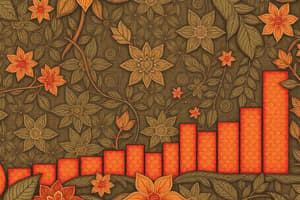Podcast
Questions and Answers
What is the correct interpretation of the mode in the provided IQ scores?
What is the correct interpretation of the mode in the provided IQ scores?
- The score that has the highest standard deviation.
- The average of all IQ scores.
- The median score of the IQ distribution.
- The score that appears most frequently among the IQ scores. (correct)
Which test is classified as a statistical normality test?
Which test is classified as a statistical normality test?
- Shapiro-Wilk test (correct)
- Histogram analysis
- Box plots
- Q-Q probability plots
When is the normality assumption necessary for statistical tests?
When is the normality assumption necessary for statistical tests?
- Only when the sample size is small. (correct)
- When the sample size is large and the data is heavily skewed.
- Only for categorical data analyses.
- For all types of statistical analyses, regardless of sample size.
In what situation would you use a non-parametric test?
In what situation would you use a non-parametric test?
Which of the following characteristics is NOT true about the standard normal distribution?
Which of the following characteristics is NOT true about the standard normal distribution?
What is the role of the central limit theorem in statistics?
What is the role of the central limit theorem in statistics?
Which graphical method is commonly used to assess normality in data?
Which graphical method is commonly used to assess normality in data?
For which type of data would you typically prefer a parametric test?
For which type of data would you typically prefer a parametric test?
What does it indicate if a dataset has multiple modes?
What does it indicate if a dataset has multiple modes?
What is the definition of median in a data set?
What is the definition of median in a data set?
In the given IQs data, what is the median IQ?
In the given IQs data, what is the median IQ?
Which of the following statements is true regarding the concept of an outlier?
Which of the following statements is true regarding the concept of an outlier?
If the 50th percentile is also known as the median, what does it indicate about a data set?
If the 50th percentile is also known as the median, what does it indicate about a data set?
What is the mode in a given data set?
What is the mode in a given data set?
If the mean of a data set is significantly affected by an outlier, which measure is less influenced by extreme values?
If the mean of a data set is significantly affected by an outlier, which measure is less influenced by extreme values?
When looking at a data set consisting of students' IQs, which value can represent an outlier?
When looking at a data set consisting of students' IQs, which value can represent an outlier?
If three values in a data set are repeated multiple times, how is their frequency classified?
If three values in a data set are repeated multiple times, how is their frequency classified?
Why might the mean not be a good representation of a data set that includes outliers?
Why might the mean not be a good representation of a data set that includes outliers?
Which of the following best describes the interquartile range?
Which of the following best describes the interquartile range?
What type of data is collected based on attributes like sex and color?
What type of data is collected based on attributes like sex and color?
Which measure is NOT commonly considered a measure of central tendency?
Which measure is NOT commonly considered a measure of central tendency?
Which type of data includes values that can take any value in a given range, including decimals?
Which type of data includes values that can take any value in a given range, including decimals?
Outliers can significantly impact which measure of central tendency?
Outliers can significantly impact which measure of central tendency?
What is the primary purpose of descriptive statistics?
What is the primary purpose of descriptive statistics?
Which of the following is an example of a measure of variation?
Which of the following is an example of a measure of variation?
The range of a dataset is defined as:
The range of a dataset is defined as:
Which statistical concept gives a single number characterizing an entire distribution?
Which statistical concept gives a single number characterizing an entire distribution?
Which of these types of data can take only fixed values and includes whole numbers?
Which of these types of data can take only fixed values and includes whole numbers?
In the context of descriptive statistics, percentiles are used to determine:
In the context of descriptive statistics, percentiles are used to determine:
What does SPSS stand for in its original form?
What does SPSS stand for in its original form?
Which of the following correctly defines a 'sample'?
Which of the following correctly defines a 'sample'?
What is NOT one of the four levels of measurement scales?
What is NOT one of the four levels of measurement scales?
Which term refers to the units on which characteristics are measured?
Which term refers to the units on which characteristics are measured?
Which of the following best describes 'observations' in statistical terms?
Which of the following best describes 'observations' in statistical terms?
What does the term 'population' refer to in a research context?
What does the term 'population' refer to in a research context?
In statistical analysis, which of these is NOT a characteristic of variables?
In statistical analysis, which of these is NOT a characteristic of variables?
What is the primary distinction between descriptive and inferential statistics?
What is the primary distinction between descriptive and inferential statistics?
What type of data is described as a composite measure of a variable?
What type of data is described as a composite measure of a variable?
Flashcards
Median
Median
The middle value in a dataset when arranged in order. It divides the dataset into two equal halves, meaning 50% of the data points are above and 50% are below it.
Outlier
Outlier
A data point that is significantly different from the rest of the data in a dataset. It's an outlier if it's far away from the other data points.
Mean
Mean
The average of all the values in a dataset. It's calculated by summing all the values and dividing by the number of values.
Interquartile Range
Interquartile Range
Signup and view all the flashcards
Mode
Mode
Signup and view all the flashcards
Data
Data
Signup and view all the flashcards
Variable
Variable
Signup and view all the flashcards
Observation
Observation
Signup and view all the flashcards
Population
Population
Signup and view all the flashcards
Sample
Sample
Signup and view all the flashcards
Descriptive Statistics
Descriptive Statistics
Signup and view all the flashcards
Inferential Statistics
Inferential Statistics
Signup and view all the flashcards
Scale
Scale
Signup and view all the flashcards
Nominal Scale
Nominal Scale
Signup and view all the flashcards
Ordinal Scale
Ordinal Scale
Signup and view all the flashcards
Normal Distribution
Normal Distribution
Signup and view all the flashcards
Central Limit Theorem
Central Limit Theorem
Signup and view all the flashcards
Standard Normal Distribution (z-distribution)
Standard Normal Distribution (z-distribution)
Signup and view all the flashcards
Normality Test
Normality Test
Signup and view all the flashcards
Parametric Test
Parametric Test
Signup and view all the flashcards
Nonparametric Test
Nonparametric Test
Signup and view all the flashcards
Choosing Parametric or Nonparametric Test
Choosing Parametric or Nonparametric Test
Signup and view all the flashcards
Qualitative Data
Qualitative Data
Signup and view all the flashcards
Quantitative Data
Quantitative Data
Signup and view all the flashcards
Discrete Data
Discrete Data
Signup and view all the flashcards
Continuous Data
Continuous Data
Signup and view all the flashcards
Measures of Central Tendency
Measures of Central Tendency
Signup and view all the flashcards
Measures of Variation
Measures of Variation
Signup and view all the flashcards
Standard Deviation
Standard Deviation
Signup and view all the flashcards
Study Notes
Statistical Workshop Series
- Workshop 1 focuses on SPSS introduction, data, and its attributes.
SPSS Software
- Originally stood for Statistical Package for the Social Sciences (SPSS).
- Now named Statistical Product and Service Solutions.
Data
- Data is all collected information to answer research questions.
Variables
- Variables include outcome, treatment, and study population characteristics.
Subjects
- Subjects are units where study characteristics are measured.
Observations
- Observations are data elements.
Population
- Population includes all subjects of interest.
Samples
- Samples are subsets of a population used for data collection.
Descriptive vs Inferential Statistics
- Descriptive statistics summarize characteristics of data.
- Inferential statistics use sample data to draw conclusions about a population.
Sample and Population Measures
- Population: Parameter represents a characteristic.
- Sample: Statistic represents a summary of a characteristic.
Data Types
- Qualitative: Data based on attributes (e.g., sex, color).
- Subcategories include: Binary, Nominal, Ordinal.
- Quantitative: Data based on measurement (e.g., arch length).
- Subcategories include: Discrete, Continuous.
- Discrete data takes on whole number values (e.g., number of visits to a dentist).
- Continuous data takes any value within a range (e.g., height in cm).
Scales of Measurement
- Scales categorize data in various ways.
- Nominal: Unordered categories (e.g., male/female).
- Ordinal: Ordered categories (e.g., pain levels).
- Interval: Ordered with equal intervals (e.g., temperature).
- Ratio: Ordered with equal intervals and a true zero (e.g., height).
Data Representation
- Data can be presented graphically using bar charts or histograms.
- Bar charts display count data in categories.
- Histograms display continuous data as frequencies.
Measures of Central Tendency
- Mean: Average value.
- Median: Middle value.
- Mode: Most frequent value.
Measures of Dispersion
- Range
- Variance
- Standard Deviation
- Standard Error
Normal Distribution
- A symmetrical bell-shaped curve.
- Describes how data is distributed.
The Empirical Rule
- 68% of data falls within one standard deviation of the mean.
- 95% of data falls within two standard deviations of the mean.
- 99.7% of data falls within three standard deviations of the mean.
Central Limit Theorem
- States that the sum of many independent random variables can approach a normal distribution.
- Assumes a large amount of data to apply.
Normality Testing
- Statistical tests (Kolmogorov-Smirnov, Shapiro-Wilk) to check data distribution.
- Graphical plots (Q-Q plots, boxplots) to visualize data distribution.
When to use parametric and non-parametric tests
- Parametric tests are used when mean of data represents the distribution.
- Nonparametric tests are used when median is the measure of the distribution or when data has small sample sizes or is ordinal or nominal.
Nonparametric Tests
- Include chi-square, Wilcoxon, Mann-Whitney, Kruskal-Wallis, Friedman, and Spearman-rank correlation.
Q&A
- P-values greater than 0.05 indicate results are not statistically significant.
Studying That Suits You
Use AI to generate personalized quizzes and flashcards to suit your learning preferences.




